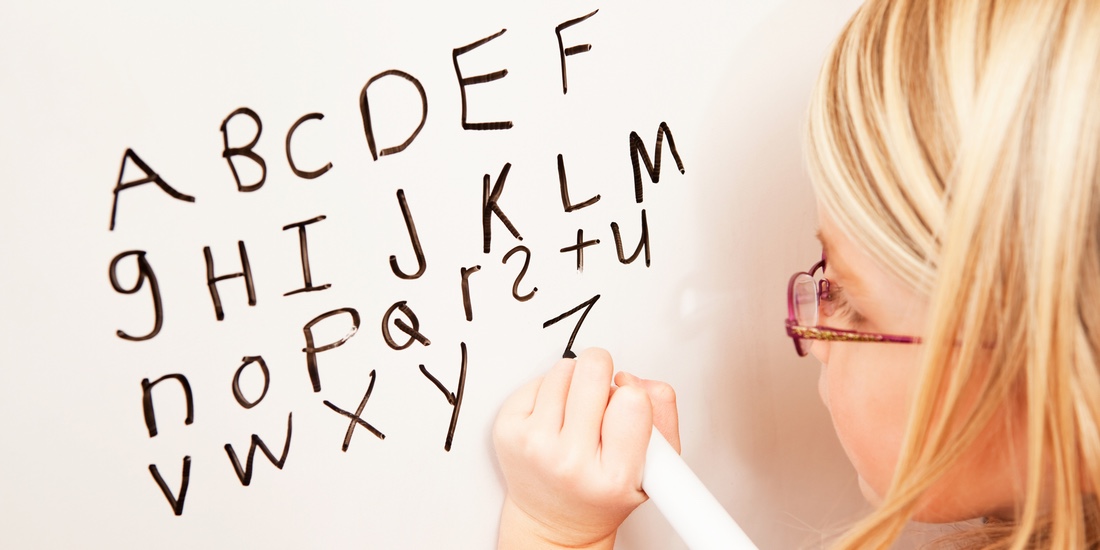Is writing letters backwards OK, or is it an early warning sign of a learning difference? Let’s tackle this very common question and equip you with some practical tools to support your child.
(Note – Learning to write is a different issue from learning letters or numbers. Learning to write is about fine motor development.)
Learn
While reversing letters could possibly indicate a learning difference, it is also extremely common in many neurotypical children. Our brains have been evolutionarily wired to visually recognize shapes and objects as the same thing, regardless of direction.
- Consider this – grab a cup and twirl it around, hold it upside down, place it on its side. Still a cup.
- Take a look at the letters ‘s’ and ‘z’ or ‘b’, ‘d’, ‘p’ and ‘q’ – they’re all virtually the same shape. “See” why many children have difficulty with them?!
- That’s how children often “see” letters, and understandably so, as most things in our world function this way except our chosen symbols of communication: letters and numbers.
Basic Concepts
What does it mean to reverse letters? This can include both flipping a letter or number to its mirror image or even writing whole words and sentences in mirror form. Again, to a new, learning brain, it shouldn’t matter the order, right? We have to teach children that for this particular skill, the position does in fact matter.
When a child begins to read and write, they need to identify objects based on:
- One particular direction and
- One particular placement.
A child has to move away from identifying letters based on their way of “seeing” them, and shift towards identifying letters based on a particular direction and placement.
As a child gains more experience with reading and writing, they will learn the specific position of letters and numbers in order to communicate their meaning accurately. Note that many children continue to write some letters or numbers in mirror form until around age 7.
If they continue to flip letters and numbers, does it in fact mean a learning disorder? Not necessarily, and not necessarily the ones that may come to your mind. Specifically, some grown-ups may jump to the suspicion of dyslexia when they notice their child flipping letters. It is a myth that children with dyslexia commonly flip letters. True, some do, but many also do not. If your child continues to frequently flip letters beyond 7-years of age (or second grade), there are a few things you can do.
- Talk to your child’s teacher. Many teachers are unable to actively and consistently monitor how students are forming their letters. Bad habits and traits may then become engrained for a child. By bringing the issue to your teacher’s awareness, they can closely watch and provide more support in the classroom.
- Practice writing letters / numbers with the proper formation regularly at home. Plenty of great ideas below.
- Seek evaluation by a professional to assess if something more is contributing. Specifically, seek an evaluation from a developmental pediatrician (different from a medical pediatrician), a psychologist who specializes in assessing neuropsychological functioning, a learning specialist or an occupational therapist.
Just Remember
- Reversing letters is extremely common in many neurotypical children.
- When a child begins to read, they need to identify objects based on one particular placement and one particular direction. It takes time for children to “see” these two different ways.
- If you continue to notice frequent reversal well into and past second grade, seek support from your student’s teacher and/or a professional evaluation.
- It is never too early to start practicing letters at home.
- Make it fun!
Do
Core Marbles
- Make it fun and motivating
- Practice, practice, practice
- Monitor your child; ensure they’re using the correct stroke approach
Practice, Practice, Practice!
- Explain to your child that for a letter to be a letter it has to maintain the same position (direction and placement).
- Great printable on letter and number formation.
- Keep an alphabet nearby and help your child find the letter that needs reversing.
- Use a handwriting approach that teaches a correct starting point and stroke.
- Handwriting Without Tears is a commonly used program with free, developmentally appropriate screeners.
- Use consistent verbal cues to teach each letter that your child can put into long-term memory.
- Have your child say the phrasing with you (e.g., “Start at the top, big line down, up to the middle and bubble around”).
- Help your child rewrite the reversed letter, focusing on the correct starting point and stroke.
- Use lined paper with colors or line themes to cue formation (i.e., sky, plane, grass and worm lines).
Puzzles
- Puzzles can help reinforce the concept that position does matter, so improving your child’s visual perceptual skills is a great foundation.
- Our favorite alphabet puzzles:
Use a Multi-Sensory Approach
Explore letter practice with a variety of multimedia:
- Practice on a salt tray.
- Practice strokes with sandpaper underneath.
- Provides helpful sensory feedback as a child writes.
- Instead of paper, use shaving cream as a fun base.
- Fill a sink, tray or cookie sheet with shaving cream. Practice writing with your fingers, sticks or chopsticks.
- Use Wikki Stix to form the letters and then finger-trace the letters with the correct stroke formation.
- Bonus: ask your child to make a shape / object that starts with that letter out of the Wikki Stix.
- Paint in a bag using fingers or a dull-tipped utensil for proper pencil grasp practice.
- Practice with a stick in the sandbox or use chalk on the sidewalk.
- Have your child form letters with their bodies.
- Encourage your child to use the verbal cues you previously taught while making each stroke.
- Form letters in dough using golf tees as writing utensils.
